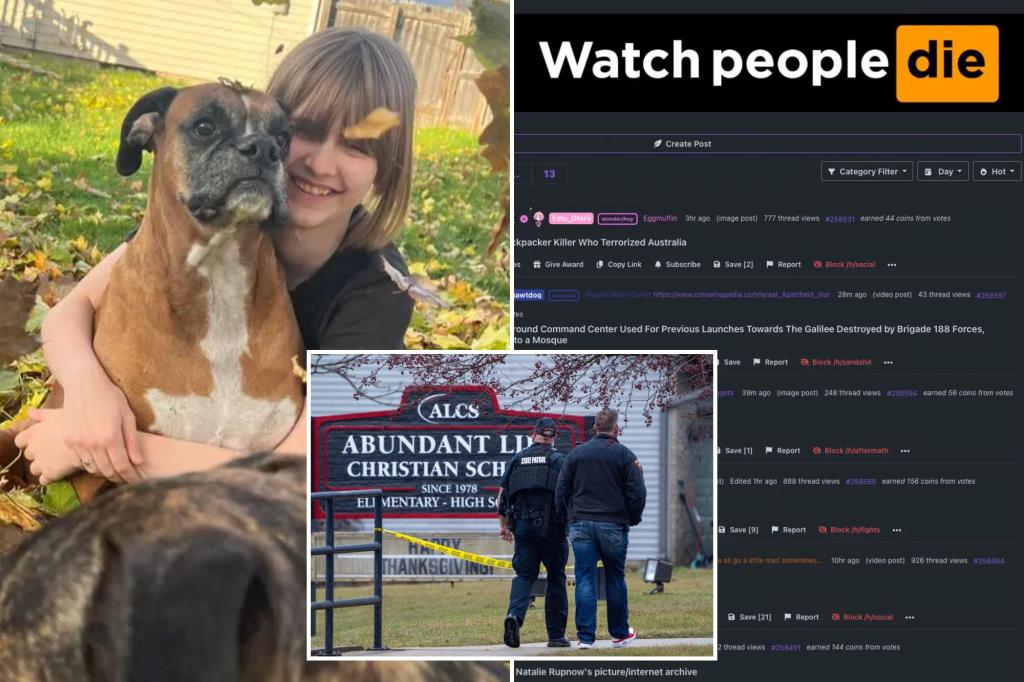Natalie “Samantha” Rupnow, a 15-year-old student at Abundant Life Christian School in Madison, Wisconsin, perpetrated a school shooting on Monday, tragically taking the lives of a teacher and a fellow student, and injuring four others before turning the gun on herself. While investigations are ongoing and a definitive motive remains elusive, Rupnow’s online activities paint a disturbing portrait of a troubled teenager with a morbid fascination with death and violence. Her apparent association with the controversial website “Watch People Die,” along with her interest in past school shootings, particularly the Columbine massacre, raise questions about the influences that may have shaped her actions.
Rupnow’s alleged online presence on “Watch People Die,” a site hosting graphic videos of death and suffering, reveals a disturbing pattern of engagement with violent content. Under the username @Crossixir, she reportedly commented on videos depicting suicide and other forms of death, expressing curiosity about the thoughts of those facing their demise. Her comments, while not explicitly endorsing violence, suggest a preoccupation with mortality and a desensitization to graphic imagery. The nature of the site itself, boasting millions of registered users, raises serious concerns about the availability and consumption of such disturbing content, and its potential impact on vulnerable individuals. The site administrator’s own message, urging users to log off and engage in more constructive activities, underscores the inherent negativity associated with the platform.
Adding to the complexity of Rupnow’s online persona is her apparent interest in past school shootings, specifically the Columbine massacre. A photo on her father’s Facebook page shows Rupnow wearing a T-shirt featuring the band KMFDM, the same band worn by Columbine shooter Eric Harris. While the photo doesn’t definitively establish a direct link between Rupnow’s actions and the Columbine shooting, it fuels speculation about the influence of such events on her mindset. The Columbine massacre remains a dark chapter in American history, and its enduring presence in popular culture raises questions about the potential for copycat violence.
The “Watch People Die” website, a platform for sharing graphic content, has become a focal point in the aftermath of the shooting. While the site administrator claims to “hate” the website and encourages users to leave, its continued existence raises questions about the ethics and legality of hosting such content. The site’s rules, which prohibit posting illegal content under US law and animal cruelty, appear contradictory to the nature of much of the material shared on the platform. The banning of Rupnow’s alleged username following the shooting highlights the site’s reactive approach to content moderation, rather than a proactive effort to prevent the spread of harmful material.
The shooting at Abundant Life Christian School, a faith-based institution, has left the community reeling. The school’s mission, centered on fostering disciples of Jesus Christ, stands in stark contrast to the violence that unfolded within its walls. School officials have expressed their faith in God’s ability to guide them through this tragedy, but the incident inevitably raises questions about the role of faith and forgiveness in the face of such horrific acts. The juxtaposition of the school’s religious values and the violent actions of one of its students presents a complex and challenging dilemma for the community to grapple with.
The ongoing investigation into the shooting will delve deeper into Rupnow’s motivations and the factors that contributed to her actions. The examination of her online activity, her apparent fascination with death and violence, and her possible interest in past school shootings will likely play a significant role in understanding the tragedy. The incident also highlights the need for a broader societal conversation about access to graphic online content, the potential impact of violent media on vulnerable individuals, and the importance of mental health resources for young people. While there are no easy answers, understanding the complex interplay of these factors is crucial to preventing future tragedies.

